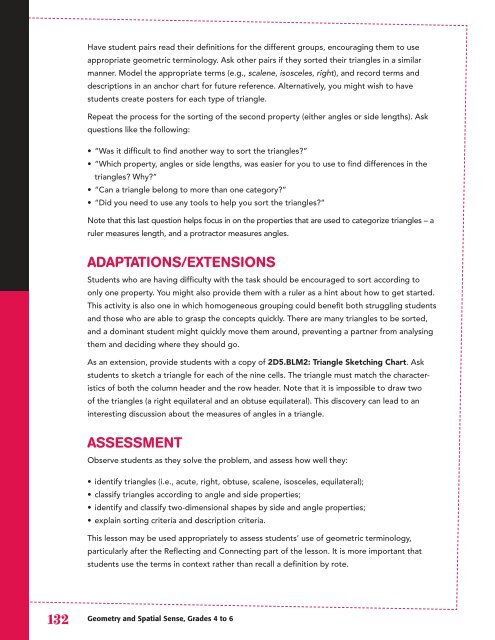Geometry and Spatial Sense, Grades 4 to 6 - EduGains
Geometry and Spatial Sense, Grades 4 to 6 - EduGains
Geometry and Spatial Sense, Grades 4 to 6 - EduGains
You also want an ePaper? Increase the reach of your titles
YUMPU automatically turns print PDFs into web optimized ePapers that Google loves.
1 2<br />
Have student pairs read their definitions for the different groups, encouraging them <strong>to</strong> use<br />
appropriate geometric terminology. Ask other pairs if they sorted their triangles in a similar<br />
manner. Model the appropriate terms (e.g., scalene, isosceles, right), <strong>and</strong> record terms <strong>and</strong><br />
descriptions in an anchor chart for future reference. Alternatively, you might wish <strong>to</strong> have<br />
students create posters for each type of triangle.<br />
Repeat the process for the sorting of the second property (either angles or side lengths). Ask<br />
questions like the following:<br />
• “Was it difficult <strong>to</strong> find another way <strong>to</strong> sort the triangles?”<br />
• “Which property, angles or side lengths, was easier for you <strong>to</strong> use <strong>to</strong> find differences in the<br />
triangles? Why?”<br />
• “Can a triangle belong <strong>to</strong> more than one category?”<br />
• “Did you need <strong>to</strong> use any <strong>to</strong>ols <strong>to</strong> help you sort the triangles?”<br />
Note that this last question helps focus in on the properties that are used <strong>to</strong> categorize triangles – a<br />
ruler measures length, <strong>and</strong> a protrac<strong>to</strong>r measures angles.<br />
ADAPTATIONS/EXTENSIONS<br />
Students who are having difficulty with the task should be encouraged <strong>to</strong> sort according <strong>to</strong><br />
only one property. You might also provide them with a ruler as a hint about how <strong>to</strong> get started.<br />
This activity is also one in which homogeneous grouping could benefit both struggling students<br />
<strong>and</strong> those who are able <strong>to</strong> grasp the concepts quickly. There are many triangles <strong>to</strong> be sorted,<br />
<strong>and</strong> a dominant student might quickly move them around, preventing a partner from analysing<br />
them <strong>and</strong> deciding where they should go.<br />
As an extension, provide students with a copy of 2D5.BLM2: Triangle Sketching Chart. Ask<br />
students <strong>to</strong> sketch a triangle for each of the nine cells. The triangle must match the characteristics<br />
of both the column header <strong>and</strong> the row header. Note that it is impossible <strong>to</strong> draw two<br />
of the triangles (a right equilateral <strong>and</strong> an obtuse equilateral). This discovery can lead <strong>to</strong> an<br />
interesting discussion about the measures of angles in a triangle.<br />
ASSESSMENT<br />
Observe students as they solve the problem, <strong>and</strong> assess how well they:<br />
• identify triangles (i.e., acute, right, obtuse, scalene, isosceles, equilateral);<br />
• classify triangles according <strong>to</strong> angle <strong>and</strong> side properties;<br />
• identify <strong>and</strong> classify two-dimensional shapes by side <strong>and</strong> angle properties;<br />
• explain sorting criteria <strong>and</strong> description criteria.<br />
This lesson may be used appropriately <strong>to</strong> assess students’ use of geometric terminology,<br />
particularly after the Reflecting <strong>and</strong> Connecting part of the lesson. It is more important that<br />
students use the terms in context rather than recall a definition by rote.<br />
<strong>Geometry</strong> <strong>and</strong> <strong>Spatial</strong> <strong>Sense</strong>, <strong>Grades</strong> 4 <strong>to</strong> 6

















